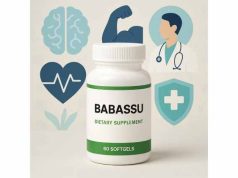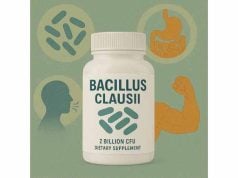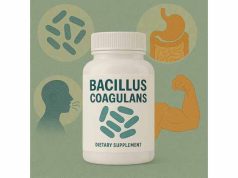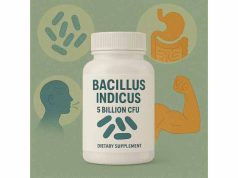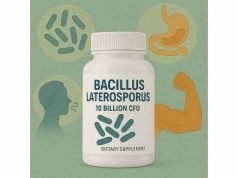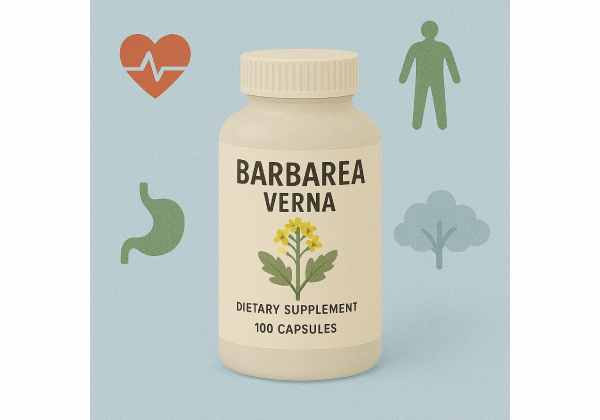
Is American cress really a forgotten superfood? Barbarea verna, also known as upland cress or early winter cress, is a nutrient-packed leafy green celebrated for its peppery flavor and impressive health benefits. Barbarea verna stands out for its concentration of vitamins A, C, and K, antioxidants, and plant compounds that support immunity, cardiovascular health, and even detoxification. Recent research highlights its role in anti-inflammatory diets and its culinary versatility, whether enjoyed raw or cooked. This guide explores how Barbarea verna works, its most compelling evidence-based uses, safe dosage recommendations, potential side effects, and answers to top questions. By the end, you’ll know exactly how to incorporate this unique green into your wellness routine for maximum benefit.
Key Takeaways
- Barbarea verna (upland cress) is a nutrient-dense leafy green high in vitamins, antioxidants, and plant phytochemicals.
- Main benefits include supporting immune health, aiding detoxification, and providing cardiovascular protection.
- It’s safe for most people when consumed as food, but large supplemental doses or extracts may cause side effects in sensitive individuals.
- Typical use is as a fresh salad green, cooked vegetable, or supplement; dosage varies with preparation method.
- Its spicy, peppery taste adds both nutrition and culinary excitement to a range of dishes.
Table of Contents
- Barbarea verna Plant Profile: What It Is and How It Supports Health
- Bioactive Compounds in Barbarea verna and How They Work in the Body
- Proven Benefits of Barbarea verna for Immunity, Heart Health, and Detox
- Barbarea verna Safety Profile: Side Effects and Interactions
- Dosage Forms, Culinary Uses, and Effective Administration of Barbarea verna
- Barbarea verna Frequently Asked Questions (FAQ)
Barbarea verna Plant Profile: What It Is and How It Supports Health
Barbarea verna, commonly known as upland cress, American cress, or early winter cress, is a leafy green vegetable native to Europe and now naturalized in North America. This cool-weather plant belongs to the Brassicaceae family—the same botanical group as broccoli, kale, and watercress—and is celebrated for its rapid growth, resilience, and distinctive spicy taste. Its botanical name honors the Roman saint Barbara, the patroness of artillerymen, reflecting its longstanding presence in gardens and fields.
Physical Characteristics and Growth Habits
Barbarea verna is an annual or biennial herb, growing to heights of 30–60 centimeters. Its glossy, dark green leaves form a loose rosette and are deeply lobed, giving them a unique, frilled appearance. In late spring, the plant produces clusters of small, bright yellow flowers atop slender stems. Upland cress thrives in moist, well-drained soils and can be cultivated almost year-round in temperate climates, making it a staple in home gardens and sustainable agriculture.
Culinary Tradition and Modern Uses
Long valued in traditional cuisine, Barbarea verna has a flavor profile similar to watercress—peppery, tangy, and slightly bitter. It’s commonly eaten raw in salads, sandwiches, and garnishes, or lightly cooked in soups, stir-fries, and egg dishes. The leaves, stems, and even flowers are edible, with the youngest, most tender leaves being preferred for their milder taste.
Beyond the kitchen, Barbarea verna has a rich history in folk medicine. It was used in Europe and colonial America to prevent scurvy—a disease caused by vitamin C deficiency—long before citrus fruits became widely available. Herbalists praised it for “purifying the blood,” stimulating digestion, and promoting overall vitality.
Nutritional Composition
Modern nutrition science confirms what traditional wisdom suspected: Barbarea verna is a true powerhouse of essential nutrients and phytonutrients. In just one serving (about 1 cup of raw leaves), you’ll find:
- Vitamin C: Supports immune function and acts as a potent antioxidant.
- Vitamin A (beta-carotene): Important for vision, skin health, and immune protection.
- Vitamin K: Key for healthy blood clotting and bone metabolism.
- Folate: Crucial for DNA synthesis and cell growth.
- Calcium, magnesium, and potassium: Provide electrolytes for muscle and nerve function.
- Dietary fiber: Supports healthy digestion and gut microbiome balance.
What’s more, Barbarea verna contains high levels of glucosinolates—sulfur-containing compounds known for their role in detoxification and cancer prevention.
Botanical Relatives and Distinguishing Features
Barbarea verna is often compared to its relative, watercress (Nasturtium officinale), but the two are distinct species with unique characteristics. Upland cress is more robust, has a longer harvest window, and is less prone to disease, making it especially attractive to organic gardeners and local food advocates.
Why Barbarea verna Is Gaining Attention
Interest in Barbarea verna is on the rise for several reasons:
- Sustainability: It’s hardy, fast-growing, and requires little pesticide input.
- Nutritional Density: Few leafy greens offer such a compact source of essential vitamins and minerals.
- Functional Food Potential: Researchers are exploring its glucosinolate content for possible roles in cancer prevention, detoxification, and anti-inflammatory diets.
- Culinary Versatility: Chefs and home cooks alike appreciate its zesty kick, which elevates everything from salads to grain bowls.
Summary Table: Barbarea verna At a Glance
| Feature | Details |
|---|---|
| Common names | Upland cress, American cress, early winter cress |
| Family | Brassicaceae (mustard family) |
| Key nutrients | Vitamins A, C, K, folate, calcium, fiber |
| Unique compounds | Glucosinolates, flavonoids, antioxidants |
| Culinary uses | Raw salads, cooked dishes, garnishes |
| Folk uses | Immune support, digestion, “blood purifier” |
Conclusion
Barbarea verna is much more than a salad green—it’s a nutritionally dense, historically significant, and highly adaptable food with a range of health-supportive properties.
Bioactive Compounds in Barbarea verna and How They Work in the Body
To truly understand Barbarea verna’s health effects, it’s essential to look beyond basic nutrition and explore its unique blend of bioactive compounds. These are natural chemicals produced by the plant that interact with our bodies at a cellular level, influencing immunity, inflammation, detoxification, and more.
1. Glucosinolates: Barbarea verna’s Star Players
Glucosinolates are sulfur-rich compounds found almost exclusively in cruciferous vegetables like Barbarea verna, broccoli, and mustard greens. When the plant’s tissues are chewed or chopped, glucosinolates are converted by the enzyme myrosinase into biologically active substances—most notably isothiocyanates and indoles.
- Isothiocyanates (such as sulforaphane) help activate detoxification enzymes in the liver, encouraging the removal of carcinogens and other toxins.
- Indoles may help balance hormone metabolism and support cellular health.
Research suggests that diets rich in glucosinolate-containing vegetables are linked to reduced cancer risk, improved liver function, and greater resilience against oxidative stress.
2. Flavonoids and Antioxidant Power
Barbarea verna is a significant source of flavonoids—natural plant pigments with potent antioxidant and anti-inflammatory properties. Major flavonoids found in this cress include quercetin and kaempferol.
- Quercetin helps stabilize mast cells (immune cells involved in allergy responses) and may provide mild anti-histamine effects.
- Kaempferol has been studied for its cardiovascular benefits, helping protect blood vessels and reduce inflammation.
Together, these compounds work to neutralize free radicals, protecting cells from oxidative damage that accelerates aging and disease.
3. Vitamins and Mineral Synergy
- Vitamin C acts as a cofactor for enzymes involved in collagen production, tissue repair, and immune defense.
- Vitamin K is crucial for proper blood clotting and healthy bones.
- Folate supports cell division and the formation of red blood cells.
Minerals like calcium, magnesium, and potassium further enhance Barbarea verna’s role in maintaining bone density, electrolyte balance, and muscle function.
4. Dietary Fiber: Feeding the Gut Microbiome
Barbarea verna provides soluble and insoluble fiber, which feed beneficial gut bacteria and support digestive health. Fiber slows the absorption of sugars, balances blood glucose, and promotes regularity.
5. Nitrates and Circulatory Support
Naturally occurring nitrates in Barbarea verna may help improve blood flow by promoting the production of nitric oxide, a molecule that relaxes blood vessels and supports cardiovascular health.
6. Potential Anti-Inflammatory Actions
The synergy between glucosinolates, flavonoids, vitamins, and minerals equips Barbarea verna with powerful anti-inflammatory effects. Early studies suggest regular consumption may help modulate inflammatory pathways and reduce chronic disease risk.
How These Compounds Work Together
When consumed as part of a whole-food diet, Barbarea verna’s compounds act in harmony:
- Supporting phase II liver detoxification
- Enhancing immune function and antioxidant defenses
- Reducing oxidative stress and inflammation
- Promoting cardiovascular and metabolic health
Summary Table: Barbarea verna’s Bioactive Compounds and Effects
| Compound Type | Key Examples | Main Health Effects |
|---|---|---|
| Glucosinolates | Sulforaphane, indoles | Detoxification, cancer risk reduction |
| Flavonoids | Quercetin, kaempferol | Antioxidant, anti-inflammatory |
| Vitamins | C, K, A, folate | Immunity, bone health, repair |
| Minerals | Calcium, potassium | Electrolyte, muscle, and nerve support |
| Dietary fiber | Soluble/insoluble | Gut health, blood sugar regulation |
Why Whole-Food Barbarea verna Matters
While supplements and extracts can be beneficial, consuming the fresh leaves ensures you’re getting the full spectrum of nutrients and plant chemicals in their natural balance—maximizing health outcomes.
Proven Benefits of Barbarea verna for Immunity, Heart Health, and Detox
Barbarea verna isn’t just a flavorful salad ingredient—it’s a functional food with significant, research-backed advantages. Here’s a closer look at its top evidence-based uses and how it supports wellness across multiple body systems.
1. Immune System Boosting and Antioxidant Protection
- The high vitamin C content strengthens immune defenses, enhancing white blood cell activity and aiding recovery from colds or infections.
- Antioxidant flavonoids and vitamin A protect cells from oxidative stress, which can otherwise weaken immunity over time.
- Studies indicate that diets high in cruciferous vegetables like Barbarea verna may lower the risk of respiratory infections and chronic inflammatory conditions.
2. Liver Support and Detoxification
- Glucosinolates, unique to Barbarea verna and other cress species, activate detoxifying enzymes in the liver.
- These enzymes help the body neutralize and eliminate environmental toxins, pesticides, and potentially carcinogenic substances.
- Regular consumption may aid in protecting the liver from damage caused by pollution, medications, or alcohol.
3. Cardiovascular Health and Blood Pressure Balance
- Natural nitrates and potassium help relax blood vessels and regulate blood pressure, supporting a healthy cardiovascular system.
- Flavonoids like kaempferol promote vascular health by reducing inflammation and protecting artery linings from oxidative damage.
- The fiber content assists in lowering LDL cholesterol, a major risk factor for heart disease.
4. Anti-Inflammatory Actions and Chronic Disease Prevention
- Consistent intake of Barbarea verna may help lower levels of C-reactive protein (CRP), a marker of inflammation in the body.
- Its anti-inflammatory compounds are of special interest in preventive nutrition for conditions such as arthritis, metabolic syndrome, and certain cancers.
5. Bone and Eye Health
- Vitamin K and calcium together support strong bones and proper blood clotting, making Barbarea verna valuable for people at risk for osteoporosis.
- Beta-carotene (vitamin A precursor) is essential for eye health, reducing the risk of night blindness and age-related vision loss.
6. Digestive Wellness and Gut Microbiome Balance
- The fiber in Barbarea verna nourishes beneficial gut bacteria, supporting digestive regularity and a balanced microbiome.
- This can help alleviate constipation, support healthy metabolism, and even positively impact mental well-being due to the gut-brain axis.
7. Culinary and Nutritional Flexibility
- Barbarea verna is easily incorporated into meals—raw in salads, as a cooked side, blended into smoothies, or used as a peppery garnish.
- Regular consumption delivers sustained, whole-food nutrition that’s more bioavailable and safer than relying solely on supplements.
User Experiences and Modern Applications
Many people notice improved energy, better digestion, and enhanced immune resilience after making Barbarea verna a dietary staple. Chefs praise its ability to brighten dishes with both color and flavor, while nutritionists value its nutrient density.
Limitations and Individual Response
While Barbarea verna offers broad benefits, results may vary based on genetics, gut health, and overall diet quality. Those with thyroid disorders should be aware that high intake of cruciferous vegetables can affect iodine uptake, but this risk is minimal with moderate, food-based consumption.
Summary Table: Barbarea verna’s Evidence-Based Benefits
| Health Area | Mechanism | How to Use Effectively |
|---|---|---|
| Immunity | Vitamin C, flavonoids, antioxidants | Fresh leaves, salads |
| Liver detox | Glucosinolates, isothiocyanates | Raw/cooked greens, juices |
| Cardiovascular | Potassium, nitrates, fiber | Daily in meals/snacks |
| Anti-inflammatory | Flavonoids, vitamins, plant sterols | Regular varied consumption |
| Bone/eye health | Vitamin K, beta-carotene, calcium | Add to diverse recipes |
Conclusion
Incorporating Barbarea verna into your diet is a simple yet powerful way to boost nutrient intake, support detoxification, and protect against chronic disease—making it one of the most underrated greens for holistic health.
Barbarea verna Safety Profile: Side Effects and Interactions
Barbarea verna, like most leafy greens, is generally safe for the vast majority of people when consumed as a whole food. Its long history in traditional diets attests to its low risk of toxicity or adverse reactions, especially when eaten in the typical amounts found in salads, cooked dishes, or as a culinary herb. However, as with any potent plant, there are important considerations regarding safety, possible side effects, and potential interactions—especially when using concentrated extracts or supplements.
General Tolerability and Common Experiences
Most individuals who enjoy Barbarea verna as part of their meals experience no negative effects. It’s gentle on the stomach, non-irritating, and, for most, easily digested. Its high water content and fiber may even ease digestion for those prone to mild constipation or irregularity. People switching to a diet rich in greens, however, might notice minor, temporary digestive changes (such as increased gas or bloating), which typically subside as the body adapts.
Potential Side Effects
While side effects are rare, several specific scenarios deserve attention:
- Gastrointestinal Upset: Consuming very large quantities of raw Barbarea verna may, in sensitive people, cause mild stomach discomfort, bloating, or loose stools due to its fiber and certain plant compounds.
- Goitrogenic Effects: Like many cruciferous vegetables, Barbarea verna contains goitrogens—substances that can interfere with iodine absorption and thyroid function if consumed in excessive amounts. For most people, especially those with normal thyroid health and adequate iodine intake, this is not a concern. However, individuals with diagnosed thyroid disorders (especially hypothyroidism) should enjoy Barbarea verna in moderation and ensure sufficient dietary iodine, particularly if eating large portions regularly.
- Allergic Reactions: Allergic responses to Barbarea verna are extremely uncommon, but possible—particularly in those allergic to other cruciferous vegetables. Symptoms might include itching, rash, swelling, or rarely, difficulty breathing. Anyone experiencing these symptoms should discontinue use and seek medical care.
Interactions with Medications and Supplements
- Blood Thinners (Anticoagulants): Barbarea verna is rich in vitamin K, which plays a critical role in blood clotting. Individuals taking warfarin or other anticoagulant drugs should maintain consistent intake of vitamin K-rich foods to avoid affecting medication efficacy. Sudden increases or decreases in Barbarea verna consumption could alter INR (clotting) levels.
- Thyroid Medications: Large, consistent intakes of raw crucifers may interfere with thyroid hormone replacement if you have hypothyroidism. While typical dietary amounts are safe, high-dose extracts or juicing large amounts daily could be problematic.
- Lithium: Some evidence suggests cruciferous vegetables might alter how the body handles lithium, a medication used for mood disorders. This interaction is not well-documented for Barbarea verna specifically, but caution is advised with very high intake.
Pregnancy, Breastfeeding, and Special Populations
Barbarea verna is considered safe for pregnant and breastfeeding women when eaten in food amounts. Its folate, iron, and vitamin content make it a valuable addition to prenatal diets. However, as with any new food or supplement, consult your healthcare provider before consuming concentrated extracts or if you have specific health conditions.
Safety of Supplements and Extracts
Barbarea verna is increasingly found in powdered greens, capsules, and concentrated extracts. While these can offer convenience and a more potent dose of beneficial compounds, they also raise the risk of excessive intake and side effects. Choose reputable brands that test for purity and potency, and start with the lowest recommended dose to assess your body’s response.
Contamination and Quality Concerns
Whether choosing fresh greens or supplements, quality matters:
- Purchase from trusted sources to avoid contamination with pesticides or heavy metals.
- Wash fresh leaves thoroughly to remove any soil or agricultural residues.
- If wild-harvesting, positively identify Barbarea verna, as some wild greens may be toxic look-alikes.
Summary Table: Barbarea verna Safety Considerations
| Risk/Concern | Who Should Be Cautious | Advice |
|---|---|---|
| Goitrogens | People with hypothyroidism | Eat in moderation, ensure iodine intake |
| Vitamin K | People on blood thinners | Keep intake consistent |
| Allergies | Allergy-prone individuals | Watch for symptoms, discontinue if needed |
| Concentrated extracts | All users | Start low, use reputable brands |
| Medication interactions | Those on lithium or thyroid meds | Consult healthcare provider |
Final Takeaway on Safety
Barbarea verna is a safe, nourishing food for almost everyone when enjoyed as part of a varied diet. By understanding your unique health needs and making informed choices, you can safely maximize the health-promoting properties of this powerful green.
Dosage Forms, Culinary Uses, and Effective Administration of Barbarea verna
Getting the most out of Barbarea verna depends on how you choose to incorporate it into your routine. Its versatility allows for use as a fresh green, a cooked vegetable, a juiced ingredient, or a supplement—each offering unique nutritional benefits.
Fresh Leaves: The Gold Standard
- How to Use: The simplest and most effective way to benefit from Barbarea verna is by consuming the fresh leaves. Add a generous handful to salads, sandwiches, wraps, or grain bowls. The mild, peppery bite pairs well with both sweet and savory flavors.
- Portion Guidance: For most adults, 1–2 cups of raw upland cress daily is an ideal serving, providing a meaningful boost in vitamins and antioxidants without risk of overconsumption.
- Preparation Tips: Rinse thoroughly, pat dry, and use promptly for the best flavor and nutrient retention. Young, tender leaves are preferable for salads; older leaves may be cooked.
Cooking with Barbarea verna
- Methods: Sauté, steam, stir-fry, or add to soups and stews. Light cooking can mellow the sharpness of the greens and improve digestibility for sensitive individuals.
- Nutrient Note: Some vitamins (especially vitamin C) may be lost with prolonged cooking, but minerals and many phytonutrients remain stable.
Juicing and Smoothies
- How to Use: Blend a handful of fresh leaves into smoothies, green juices, or pestos. This is a fast way to concentrate nutrition, though the taste is potent—blend with fruits or milder greens to balance.
- Portion Guidance: 1/2–1 cup per smoothie or juice is ample.
Powdered and Supplement Forms
- How to Use: Barbarea verna powders or capsules can be convenient for travel or busy days. Choose organic, lab-tested products free of fillers.
- Dosage: Follow manufacturer instructions—typically, 1–3 grams daily of powdered greens or as directed by a qualified practitioner. High-dose extracts should be used cautiously, especially by those with health conditions.
Culinary Pairings and Recipe Ideas
- Salad Booster: Toss with olive oil, citrus juice, and seeds for a nutrient-dense salad.
- Egg Dishes: Stir into scrambled eggs or omelets for extra flavor and nutrition.
- Soup Topper: Add at the end of cooking soups for a fresh, peppery kick.
- Sandwich Filler: Layer with smoked salmon, avocado, or roast vegetables.
- Grain Bowls: Mix with quinoa, brown rice, or lentils and drizzle with a lemon-tahini dressing.
Storage and Shelf Life
- Fresh Greens: Store washed and dried leaves in a breathable bag in the refrigerator; use within 3–5 days.
- Powders/Supplements: Keep sealed in a cool, dry place, away from direct sunlight and moisture.
When to Take Barbarea verna
- With Meals: Most effective when paired with meals to maximize absorption of fat-soluble vitamins (A, K). Add to lunch or dinner plates, or blend into snacks and drinks throughout the day.
- Consistency: Regular, moderate consumption yields the best results. Aim for daily or near-daily inclusion rather than sporadic large amounts.
Children, Older Adults, and Special Diets
- Safe for all ages when introduced gradually. Adjust portions based on appetite, digestive comfort, and dietary needs.
Cautions and Best Practices
- Start with small amounts if new to cruciferous vegetables to let your digestion adjust.
- For those with kidney stones, be mindful of oxalate content, though Barbarea verna is not among the highest-oxalate greens.
Summary Table: Practical Uses and Dosage
| Form | Typical Amount | How to Use | Best For |
|---|---|---|---|
| Raw leaves | 1–2 cups/day | Salads, sandwiches, garnishes | Maximum nutrient retention |
| Cooked leaves | 1/2–1 cup/day | Sauté, soup, egg dishes | Easier digestion, variety |
| Juice/smoothie | 1/2–1 cup/day | Blend with fruits/veggies | Quick nutrition, on-the-go |
| Powder/capsules | 1–3 g/day | Add to water or take as capsule | Convenience, supplementation |
By incorporating Barbarea verna into your daily meals, you’ll enjoy both its culinary pleasures and its many health rewards.
Barbarea verna Frequently Asked Questions (FAQ)
What is Barbarea verna and how is it different from watercress?
Barbarea verna, or upland cress, is a peppery leafy green from the Brassicaceae family, related to watercress but with a more robust growth and slightly stronger flavor. It’s easier to grow in a range of soils and is often used as a salad green or cooked vegetable.
Is Barbarea verna safe to eat every day?
Yes, Barbarea verna is safe for daily consumption in typical food amounts. Its nutrients and antioxidants make it a valuable staple for most people. Those on blood thinners or with thyroid conditions should monitor intake and consult a healthcare provider.
What are the main health benefits of Barbarea verna?
Barbarea verna supports immune health, detoxification, cardiovascular function, and digestion. Its vitamins, minerals, and plant compounds help fight oxidative stress and inflammation, and may contribute to bone and eye health.
Can you cook Barbarea verna, or should it only be eaten raw?
Barbarea verna is delicious both raw and cooked. Lightly cooking it softens its flavor and texture while retaining most nutrients, but eating it raw provides the maximum vitamin C and antioxidant content.
Does Barbarea verna interact with medications?
Because Barbarea verna is high in vitamin K, it may interact with blood thinners like warfarin. Very high, regular intakes may also affect thyroid medication. For most people, moderate consumption poses no issue.
How much Barbarea verna should you eat for health benefits?
A serving of 1–2 cups of raw leaves or 1/2–1 cup cooked daily provides a robust dose of nutrients and plant compounds for wellness support. Supplements should be used as directed.
Where can I buy Barbarea verna or upland cress?
You can find fresh Barbarea verna at farmers’ markets, specialty grocers, and sometimes supermarkets. Seeds are widely available for home gardening, and supplements can be purchased online or at health food stores.
Disclaimer:
This article is intended for educational purposes only and does not substitute for medical advice, diagnosis, or treatment. Always consult your healthcare provider before making significant dietary changes or starting new supplements, especially if you have health conditions, are pregnant, or take medication.
If you found this resource helpful, please share it with friends on Facebook, X (formerly Twitter), or your favorite social platform—and follow us for more wellness insights. Your support helps us bring quality, evidence-based content to more readers. Thank you!


